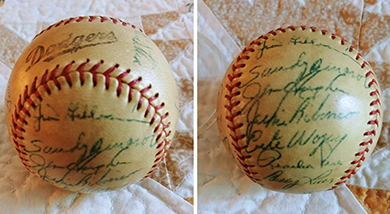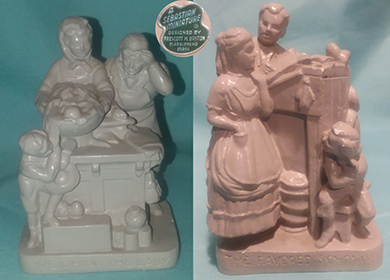 |
|
|||
 |
 |
|||
RINKER ON COLLECTIBLES — Column #1649 Copyright © Harry Rinker, LLC 2018 Questions
and Answers
QUESTION: In a small box of coins that I bought, I found a bronze coin/medal, slightly bigger than a half dollar, that has a bust of Robert E. Lee surrounded by “REUNION UNITED CONFEDERATE VETERANS / MAY 15-18, 1911 / GEN. R. E. LEE / LITTLE ROCK, ARK” on the obverse and three Confederate battle flags on the reverse. The coin/medal is worn but readable. What information can you provide about this piece? – W. P., Fountaintown, IN, Letter ANSWER: Just like the GAR (Grand Army of the Republic), the Confederate veterans of the Civil War held annual reunions. The 21st reunion of the United Confederate Veterans took place in Little Rock, Arkansas, on May 16-18, 1911. More than 100,000 people attended, approximately 12,000 of which were Confederate veterans. The United Confederate Veterans was founded in 1889 for the purpose of keeping alive the memories of those who fought for the South and to bring attention to the needs of aging veterans. Little Rock established a veterans’ tent camp in what is now known as MacArthur Park. The camp was named for Confederate Colonel Robert Glenn “Fighting Bob” Shaver of the Seventh Arkansas Infantry. The camp layout was arranged by state, division, and corps. In addition to the “official” parade of veterans on May 18, events included arcades, dances, hot air balloon rides, and receptions. 5,800 individuals attended the final Veterans’ Ball. [For more information, see: www.encyclopediaofarkansas.net/encyclopedia/entry-detail.aspx?entryID=43] The Little Rock United Confederate Veterans Reunion marked the high-water mark for the organization. Attendance steadily diminished. The 1951 61st Reunion held in Norfolk, Virginia, was the final one. Three veterans attended. The United States Postal Service issued a special stamp honoring the event. A variety of souvenir badges, medals, pinbacks, programs, and other memorabilia were issued for the event. In addition to the coin/medal, the same design was used as an attachment to a badge with a metal banner on the top reading “SOUVENIR.” In researching prices, I found a seller offering an identical coin/medal but in much better condition for $32.00. A coin/medal in fine condition sold on eBay in July 2017 for $32.00. Given the heavily worn condition of your coin/medal and market availability of examples in very good or better condition, your example has a value between $8.00 and $12.00, obviously, more valued in the South than the North. Ray and Steve Hanely’s “Remembering Arkansas Confederates and the 1911 Little Rock Veterans Reunion,” published by Arcadia Publishing in 2006, is available for sale on Amazon.com. QUESTION: My father was a friend of Carl Furillo, known as “The Reading Rifle,” who played baseball for the Brooklyn and Los Angeles Dodgers. In the 1950s, my father acquired a signed baseball from Furillo that contained the following signatures—Walter Alston (manager), Sandy Amoros, Roy Campanella, Bob Darnell, Carl Erskin, Carl Furillo, Jim Gilliam, Don Hoak, Jim Hughes, Clem Labine, Tom Lasorda, Billy Loes, Walt Moryn, Johnny Padres, Pee Wee Reese, Jackie Robinson, Preacher Rowe, Duke Snider, Rube Walker, and Pete Wojey. What is the value of my baseball? ---L, Reading, PA, Email Question 
ANSWER: The manager and the 21 players whose names appear on your ball played for the 1954 Brooklyn Dodgers. The critical question is: are these signatures authentic? After carefully reviewing the two images of the signatures that you emailed, I have a number of concerns. First, all the signatures are written with the same pen or pen type. If the ball was one of several being passed around within the clubhouse, this might have occurred. Second, almost all of the signatures have the same slope. In a group of 21 individuals, this is highly improbable. Third, I compared more than a dozen of the signatures on your ball with online examples of the same individuals. Realizing that individual signatures vary, especially when signed on a baseball, I still noticed significant differences. In my opinion, you have a clubhouse ball. These balls usually contained a few authentic signatures with the rest of the names being added by someone in the clubhouse, a batboy or other employee. Although clubhouse balls do have value, the value is far less than if it contained all authenticated signatures. If I am correct, the value of your ball is between $200.00 and $250.00 unless the signature of one of the Hall of Fame members should prove authentic. The Professional Sports Authenticator (PSA), www.psacard.com, is one of the leading authentication grading services. It offers an autographed baseball service. The beginning fee is $75.00. If the baseball is graded and valued above $1,000.00, the fee increases based on value. An internet search will reveal additional companies offering the same service. It is your decision whether to invest the $75.00 or more to have the ball authenticated. If some of the signatures, especially the Hall of Fame players, are authenticated, the money will be well spent. If they are not, you will have spent almost half of what the ball is worth to learn the truth. There is another possible approach. You can contact one or more of the leading sports auction houses, send them the pictures of the signatures on your ball, and suggest you are considering selling it and would like to know their opinion of its salability. Authentication is a matter of opinion no matter how scientific the authenticators make it appear. Experts do differ. No authenticator is correct 100 percent of the time. As to the value of your ball, there is no sense speculating until the question of signature authentication is determined. QUESTION: I have two Sebastian miniatures, each with a palette-like green and silver foil reading “A / SEBASTIAN / MINIATURE / ® / DESIGNED BY / PRESCOTT BASTON / MARBLEHEAD / MASS.” The first is “Weighing the Baby” and the second “The Favored Scholar.” Each has a tan colored glaze. What is their value? – AP, Email Question 
ANSWER: Prescott W. Baston designed the figurines that became known as Sebastian Miniatures. His son “Woody” Baston continued the business after his father died in 1984. From 1938 to 1945, the miniature figurines were made in Arlington, Massachusetts, from 1946 to 1975 in Marblehead, and from 1976 to 1997 in Hudson, New York, in cooperation with Lance Corporation. In 1998 production moved to Wayland, Massachusetts. Sebastian miniatures are identified by SML numbers. “The Favored Scholar” is SML-193, and “Weighing the Baby” is SML-195. According to listings on Worthpoint.com, a solid color SML-193 sold on eBay in April 2017 for $49.00. A solid color SML-195 sold on eBay in February 2017 for $122.50. A current eBay seller is asking $195.00 plus $3.75 shipping for an SML-195. The majority of Sebastian miniature collectors are focused in New England and the Middle Atlantic States. Prices for older examples, such as the miniatures you own, are relatively stable. Values for recent and later figurines declined significantly following the 2008-2009 great recession. Once upon a time, there was a Sebastian Miniature Collectors Society. It appears to no longer be in operation. Prescott W. “Woody” Baston, Jr., died on January 11, 2018. QUESTION: I have a musical bank that measures 5 1/2-inches wide and 7-inches high. The front has a red frame featuring a center image of a young boy carrying a baseball bat and accompanied by a dog walking inside a ballpark. When a penny is inserted, the bank plays “Take Me Out to the Ball Game” and the boy moves about. The back is marked “G12/41 / OTAGIRI / JAPAN” below which is “OTAGIRI © GIBSON GREETING CARDS, INC.” What is my bank worth? -- TP, Reading, PA, Email 
ANSWER: Otagiri is most associated with stoneware pieces sold at West Coast department stores and outlets beginning in the 1950s. According to an article on eBay, “The Otagiri Mercentile [sic.] Company (OMC) imported the handcrafted and hand-painted ceramics made in Japan for distribution to high-end department stores as well as gift shops mainly in San Francisco. OMC also functioned as a third party manufacturing company, making products for other organizations like the San Francisco Music Box Company and Gibson Greetings….After operating for more than two decades, OMC finally registered as a trademark in 1980 in the US….” [See: www.ebay.com/gds/What-is-Otagiri-/10000000205597392/g.html] Your music box was sold in a cardboard container with an opening in the front showcasing the young boy with the bat. WorthPoint.com lists an example in working order and with its period box that sold on eBay In October 2017 for $11.25. Since your example is missing the period box but is in very good or better condition, a realistic secondary market value is between $8.00 and $10.00. Harry L. Rinker welcomes questions from readers about
collectibles, those mass-produced items from the twentieth and twenty-first centuries.
Selected letters will be answered in this column.
Harry cannot provide personal answers.
Photos and other material submitted cannot be
returned.
Send your questions to: Rinker on Collectibles, 5955 Mill
Point Court SE, Kentwood, MI 49512.
You also can e-mail your questions to
harrylrinker@aol.com.
Only e-mails containing a full name and mailing address
will be considered.
You can listen
and participate in
WHATCHA GOT?, Harry’s
antiques and collectibles radio call-in show, on Sunday mornings between 8:00 AM
and 10:00 AM Eastern Time.
If you
cannot find it on a station in your area,
WHATCHA GOT?
streams live on the Internet at www.gcnlive.com.
|
||||